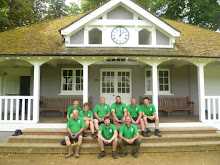 |
| Birch Coppice |
Five members of the team, Ali, Kieron, Graham, Callum and Peter spent the day working with the arboriculturalists, tree surgeons, of the University of Oxford's Harcourt Arboretum. The reason for their 'away day' was to coppice the birch and hazel for the creation of this year's plant supports on the herbaceous border and and a new border edge on the lakeside broadwalk respectively.
 |
| Cutting Down The Birch |
They began their day in an area of 8 year old silver birch trees that required cutting down. These older trees had been used as a natural wind break protecting the younger, newly planted trees amongst them but, as these newer trees had established themselves, the older trees were no longer required and could be cut down and used for the plant supports. The birch occupies an area that was farmland just 10 years ago and since that time the birch has been allowed to colonise the land naturally and is now part of the managed woodland of the arboretum, the silver birch is known as a 'pioneer' species, one of the first species that will occupy suitable land.
 |
| Step Cut |
Having been shown two different types of cut by the arboriculturalists, the step cut and gob cut, the team, preferring the step cut, cut down 130 birch trees and dragged them to the awaiting trailer where they were processed, the thick lower trunk was cut off and discarded for chipping leaving the multi branched top lengths of 8 to 10 foot, perfect for a plant support. For birch plant supports see blog entry 15th March 2011, 'Basket Weaving'. The remainder of the trunk below the step cut was then cut down to a few inches above the ground, known as a stump or a stool, and will regrow as the dormant buds burst into life creating new, replacement birch trees.
 |
| It Takes Two |
 |
| Dragging The Birch |
 |
| A Birch Stool |
 |
| A Trailer Full |
Once the team had finished cutting down the birch they moved on to the hazel coppice. The hazel has produced many 'rods' since it was last 'coppiced', cut down, about 5 years ago and is ready to be coppiced again, these rods being perfect material for the basket weaved border edging.
 |
| Hazel Coppice |
 |
| Hazel |
The hazel was cut down to 2-3 inches above the ground using a chainsaw, the remaining stool, as with the birch, will create new growth from the dormant buds.
 |
| A Hazel Stool |
 |
| Cut Down Hazel |
The cut down hazel was then processed, the branches and side shoots removed using a billhook to create a clean, single rod of hazel. The bent, curved, crooked rods were also cleaned but cut in to pieces to create piles for natural homes for wildlife, and the thicker pieces will be used as hedging stakes.
 |
| Bill Hooking The Hazel |
 |
| Perfect Cleaned Hazel Rod |
 |
| The Team Bill Hooking Hazel |
By the end of the day the team had cut and processed 130 birch trees and a similar amount of hazel rods, both of which will be delivered to the college tomorrow. The new hazel basket weave edge will be created next week and the birch plant supports in the spring, April-May.
 |
| Processed Hazel |
 |
| Ready For Delivery |
 |
| Billhook |
 |
| A Nature Pile |
Update
The pictures below show the basket weaved edge using the coppiced hazel rods.
 |
| Hazel Basket Edging 6th February 2017 |
 |
| Basket Weave Edging |


Hello,
ReplyDeleteThank you for sharing so eloquently and engagingly all the activities around the garden!
I have a quick question, which has little to do with the post above, but will soon be seasonal - when you prick out seedlings into your square pots, what size pots do you use? I don't imagine it would make a great deal of difference, but I wonder whether to buy a batch of 7 or 9 cm ones.
Thank you,
Ana
Ana
DeleteThank you for your kind words they are very much appreciated.
The size of the pot we use for the pricked out seedlings are small black pots 7x7x8cm.
Here is a link to the blog entry of the 9th April 2015 called 'Pricking Out', i hope this helps. http://wocogaga.blogspot.co.uk/2015/04/pricking-out-2015.html
Thanks again for your comment and question. Best regards Ali